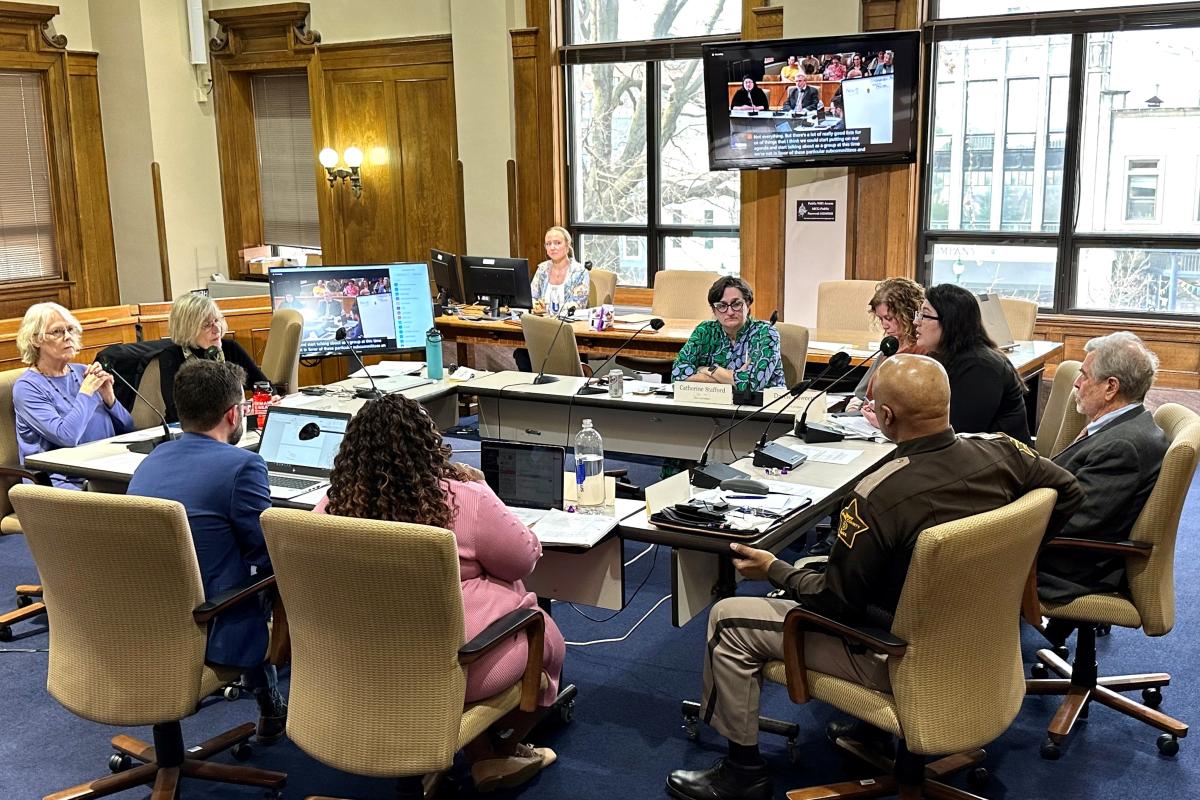
(Lucas Gonzalez)
Progress on establishing a new county jail stalled again when members of the committee discussing the initiative failed to agree on whether they should split into subgroups.
Ultimately, the Community Justice Response Committee reached no decision on the topic at its Monday meeting after some members voiced concerns.
The three county commissioners, who are leading the committee’s discussions, proposed four subgroups: facility, judicial process, treatment and case management for release and re-entry.
April Wilson, a deputy prosecutor who serves on the committee, said she is worried about the potential for “information silos” and said the committee should strive to be more collaborative.
“If I want to make different decisions, I need different information,” Wilson said. “And so, I think we’re all here in good faith to learn more information to make the system better — so if we want real justice reform, I think we need to start working collaboratively, putting these items on this agenda, and start talking about them.”
Read more: Sheriff, commissioners compromise on jail maintenance position
Wilson was referring to a request she made to add to the group’s agenda a discussion about departments that would be co-located with the jail to determine how much land would be needed for a new facility.
The commissioners were adamant that splitting into separate groups is the best course of action.
“We feel that it’s incumbent upon us to divide into subgroups because we have different roles to play here,” said Penny Githens, president of the board of commissioners. “We’re not going to tell judicial how to operate things. That’s not our role; that’s not our expertise. That’s not what we think we ought to be doing.”
Wilson said the prosecutor’s office is not in favor of the subgroups as presented by the commissioners. She also cited concerns about less public input if the committee splits into subgroups.
“I want to make sure that we’re not creating obstacles to community participation, and I think having four subcommittees plus a main committee is going to be really challenging, I think, for everyone at this table — but also for community members who have come in to learn more about the process and to understand what’s going on and to make recommendations,” Wilson said.
Read more: Sheriff working on jail ‘with or without’ commissioners’ support
Commissioner Julie Thomas echoed Githens’ point that conversations about the judicial process should be handled by experts in that field. Meanwhile, Thomas said the commissioners should quickly decide on a potential jail facility.
Monroe Circuit Court Judge Catherine Stafford agreed with the commissioners’ assessment that the committee needs to act quickly but said those conversations should be held publicly and with all members present. She recommended the committee designate meetings to specific topics instead of breaking into subgroups.
County council member Peter Iverson felt indifferent about the idea for subcommittees but said representatives of the health department should have a seat at the table again. In late January, commissioners changed the committee’s makeup by removing the county health administrator and two judges and adding Githens.
Iverson also said breaking into subgroups could be a way to incorporate members of city government into the committee’s discussions, something both the mayor’s administration and members of city council have called for.
Internal conflicts persist
At one point during the meeting, Wilson yielded time to other committee members who had raised their hands: Judge Stafford and council member Iverson. Wilson’s gesture was immediately met by pushback from Githens.
“I’m sorry, are you in charge of the meeting?” Githens said.
Wilson began to respond but was cut off by Githens. Meanwhile, Iverson interjected, “I don’t think we need that tone.”
Githens, replying to Iverson, said, “I feel like my toes are being stepped on. I, as an elected official, felt like I was being disrespected here. I really did. I saw your hand up, I saw Judge Stafford’s. I was about to call on you.”
The brief exchange was a continuation of personal disagreements on full display at recent CJRC meetings. Most recently, commissioners clashed with Sheriff Ruben Marté in the presence of an ACLU representative.
Read more: ACLU attorney calls on Monroe County to establish new jail
During the period designated for public comment, City Clerk Nicole Bolden stepped up to the podium — not in her official capacity, but as president of the Monroe County Black Democratic Caucus.
Bolden criticized the commissioners for their behavior toward county council member Jennifer Crossley and Sheriff Marté, the only two Black members of the jail committee.
“While all of the elected officials in this room have been, from time to time, treated in a manner that is less than ideal by their colleagues, Councilor Crossley and Sheriff Marté have been the direct recipients of a noticeably high number of sights, eye rolls, muttered comments, direct disparagement and cut-off statements,” Bolden said. “While I hope that it is not the intent of those engaging in this behavior to indicate any bias, the fact remains that the only two elected officials of color in this room have been treated to a high level of disrespect that does not track with the treatment of others in this room.”
Bolden also shared a message with the rest of the committee: “Say something when you see it happening, rather than remaining silent for the sake of keeping the peace or sticking to parliamentary procedure.”
Her comments were met by extended applause from members of the public.
Read more: Monroe County BZA denies zoning variance for women's shelter
Also present Monday were members of the advocacy group Care Not Cages, which is opposed to the construction of a new jail. The group hosted a block party outside the courthouse before the meeting and hosted Jauston Huerta, director of Forever on Course United in Solidarity (FOCUS) Initiatives.
Huerta told the committee he spent a total of 15 years incarcerated for non-violent charges of drug possession and dealing.
“Never once did the state say, ‘Maybe we should give this guy some type of drug treatment,” Huerta said. “The first answer was ‘We’ve got to put him in prison.’”
Huerta spoke in favor of Senate Bill 1, which aims to have mental health professionals dispatched to calls for mental health crises instead of police.
“Locking people up is not the answer,” Huerta said. “It only compounds and multiplies trauma. Trauma happens in prison; I know. Can’t nobody tell me anything different. I know; I’ve lived there.”
Commissioners present vision for new jail
For the first time Monday, commissioners presented their overall vision for a new facility. They spoke generally about improvements they’d like to see but didn’t present a plan for achieving their goals.
Some of the key goals they highlighted included reducing recidivism, introducing more programming for inmates and offering mental health and substance use disorder treatment.
The commissioners said they want a single-story jail with more space for recreation, programming and day-to-day operations. They also want to explore alternative sentencing practices and transitional housing options.
Some committee members said while they were encouraged to hear the commissioners’ goals, they are frustrated by the lack of progress being made.
There was also some disagreement over the acreage needed for a new jail. The commissioners’ estimates are in the range of 25 acres, but Judge Stafford said she had gathered data that shows it could be built within nine acres or less.
Read more: Bloomington Transit to expand Sunday service later this month
Stafford also touched on the topic of where the jail should be built. The commissioners have considered locations both in and outside Bloomington city limits.
“For Monroe County, one of our goals is to demonstrate our progressive values and to live those values,” Stafford said. “For me, that means inmates should not be hidden away in some corner of the county where they are not able to see family and friends and where they are not able to access services after their release.”
Stafford said the committee should first decide how many beds would be needed in a new jail before deciding on where a new jail would be built. She used a tail-wagging-the-dog analogy: “The ‘where it goes’ is the tail, and the ‘how many beds’ is the dog.”
On Wednesday, at the commissioners’ work session, the recommendations of a committee tasked with proposing firms to design and build a new jail will be presented to the commissioners.
The three firms under consideration are DLZ, Elevatus and RQAW.
Githens said the commissioners will likely vote whether to accept the committee’s recommendation at their regular meeting on March 22. After that meeting, the firm will be invited to give a presentation at the CJRC meeting on April 3.











